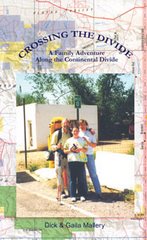
Trail that traces the Rockies' backbone through Colorado still is far from complete more than 30 years after its start
By Scott WilloughbyThe Denver Post
You would never know from the smiling faces and feel-good vibes emanating from the hardy folks entrusted with keeping the fractured spine aligned, but after 30 years of rehab there's no denying the diagnosis. The Continental Divide Trail could use a little love.
Not familiar with the CDT? Join the club.
Despite more than 30 years in the making, the so-called "King of Trails" remains third in line to the throne occupied by its more popular cousins to the east (the Appalachian Trail) and west (the Pacific Crest) when it comes to hiking empires. Although all are recognized by Congress as a result of the National Trails System Act of 1968, the 3,100-mile CDT running right down the spine of the Rocky Mountains through Colorado remains a full 1,000 miles away from fulfilling its destiny. "The trail is actually the longest north-to-south in the U.S., but there are a thousand miles of it that we haven't actually completed, that are either missing or are on roads," said Teresa Martinez, director of field operations for the Pine-based Continental Divide Trail Alliance (CDTA). "It's supposed to be kind of 'the people's trail system,' owned and maintained by the public for future generations. But people are often unaware that it even exists."
The notion of a hiking trail spanning the backbone of America would seem like a natural to many Coloradans. And indeed it did to David Maceyka of the now-defunct Rocky Mountain Trail Association, who joined Appalachian Trail founder Brenton Mackaye and members of the Colorado Mountain Club in walking a segment of the proposed CDT through Colorado back in 1966.
The so-called "Blue Can Trail" that Maceyka hiked and marked (with blue cans) for the Forest Service to locate and approve between Empire and Rocky Mountain National Park became the first leg of what now spans some 800 miles of CDT through Colorado and the impetus behind the National Trails System Act. Congress
A hiker encounters lingering snow on the Continental Divide Trail, which some call the nation's "King of Trails." ultimately voted to include a trail spanning the length of the Divide from Canada to Mexico among the National Scenic Trail system in 1978, identifying a 50-mile wide corridor on either side of the Divide to locate its final route. Problem is, Congress didn't allocate any actual land (beyond 1,900 miles of existing trails and primitive roads) or any money to the cause, leaving the trail to find its own way.
"One reason the Act was written the way it was is their belief in volunteerism, through that public engagement and empowering and ownership of this trail system, that money would not be as critical because you'd have these volunteers and that support system to work with the (federal) agencies to accomplish great things," said Martinez, a former trail program manager for the Appalachian Trail Conservancy. "With the CDT, the organization is preceding the cause in many ways. A lot of clubs have embraced the trail, but they're not organized solely as trail clubs that maintain and manage and advocate for the CDT. That's where the CDTA has been really strong in providing that volunteer component."
Minimal coordination among agencies and nearly nonexistent public involvement for almost two decades ultimately led to the 1995 creation of the CDTA, whose 3,000 members remain devoted to the completion, maintenance and protection of the trail 30 years after its nascence.
CDTA officials estimate that 70 percent of the often stunning trail spanning five states, 20 wilderness areas, three national parks and 25 national forests is usable today. The estimated cost to complete a scenic trail away from motorized routes is another $27 million. The return, according to some, is priceless.
"I feel sorry for people who don't ever get to see this," said Ken Thompson, who made the trip from Lawrence, Mich., to attend last weekend's annual Trailfest celebration of the CDT in Buena Vista.
Thompson and his wife, Kim, were hiking a new segment of the CDT above 12,200-foot Cottonwood Pass to fulfill the wish of his recently deceased farming partner, Ray Miller, who donated 10 percent of his estate to the CDTA after through-hiking the trail years ago.
"He wanted me to come here with him for years," Thompson said. "Now I can see why."
Hundreds of others took part in the CDTA's annual awareness event, which included guided hikes as both a showcase and a recruiting effort for the trail. While the remoteness of the CDT provides a memorable experience that is increasingly sought and difficult to find, it also speaks to the physical challenges trail managers face in fulfilling their vision.
"That elevation and exposure factor is a challenge that something like the AT doesn't have, but it's also the beauty of it," Martinez said. "That's why our volunteers are so uniquely special, because they buy into that hook, line and sinker — game on."
And not surprisingly, Colorado leads the CDTA's volunteer efforts with roughly half of the 900 annual trail builders hailing from the state with the highest concentration of tall peaks in the nation. Some 43 projects are in the works trailwide this summer. Still, of the 800 miles of the Divide Trail passing through Colorado, 225 remain to be completed or rerouted.
Completed or not, the CDTA has set a goal of 2018 to at least have the entire trail mapped out, away from roads and closer to the original vision of a truly scenic national trail.
"Will it ever be done? I think that's up to the American public to determine," Martinez said. "I think there will always be something to be done. It's a legacy project that engages every single one of our citizens and it will depend upon every generation to make sure that it continues to exist.
"A trail is a living organism. The public can be a part of that life. But it's a lot of work."
Get involved: The Pine-based Continental Divide Trail Alliance offers volunteer opportunities spanning from half a day to five days with levels of difficulty ranging from family-friendly to full-blown backpacking. Find out more by visiting http://www.cdtrail.org/ or calling 303-838-3760 or 800-909-CDTA.
You would never know from the smiling faces and feel-good vibes emanating from the hardy folks entrusted with keeping the fractured spine aligned, but after 30 years of rehab there's no denying the diagnosis. The Continental Divide Trail could use a little love.
Not familiar with the CDT? Join the club.
Despite more than 30 years in the making, the so-called "King of Trails" remains third in line to the throne occupied by its more popular cousins to the east (the Appalachian Trail) and west (the Pacific Crest) when it comes to hiking empires. Although all are recognized by Congress as a result of the National Trails System Act of 1968, the 3,100-mile CDT running right down the spine of the Rocky Mountains through Colorado remains a full 1,000 miles away from fulfilling its destiny. "The trail is actually the longest north-to-south in the U.S., but there are a thousand miles of it that we haven't actually completed, that are either missing or are on roads," said Teresa Martinez, director of field operations for the Pine-based Continental Divide Trail Alliance (CDTA). "It's supposed to be kind of 'the people's trail system,' owned and maintained by the public for future generations. But people are often unaware that it even exists."
The notion of a hiking trail spanning the backbone of America would seem like a natural to many Coloradans. And indeed it did to David Maceyka of the now-defunct Rocky Mountain Trail Association, who joined Appalachian Trail founder Brenton Mackaye and members of the Colorado Mountain Club in walking a segment of the proposed CDT through Colorado back in 1966.
The so-called "Blue Can Trail" that Maceyka hiked and marked (with blue cans) for the Forest Service to locate and approve between Empire and Rocky Mountain National Park became the first leg of what now spans some 800 miles of CDT through Colorado and the impetus behind the National Trails System Act. Congress
A hiker encounters lingering snow on the Continental Divide Trail, which some call the nation's "King of Trails." ultimately voted to include a trail spanning the length of the Divide from Canada to Mexico among the National Scenic Trail system in 1978, identifying a 50-mile wide corridor on either side of the Divide to locate its final route. Problem is, Congress didn't allocate any actual land (beyond 1,900 miles of existing trails and primitive roads) or any money to the cause, leaving the trail to find its own way.
"One reason the Act was written the way it was is their belief in volunteerism, through that public engagement and empowering and ownership of this trail system, that money would not be as critical because you'd have these volunteers and that support system to work with the (federal) agencies to accomplish great things," said Martinez, a former trail program manager for the Appalachian Trail Conservancy. "With the CDT, the organization is preceding the cause in many ways. A lot of clubs have embraced the trail, but they're not organized solely as trail clubs that maintain and manage and advocate for the CDT. That's where the CDTA has been really strong in providing that volunteer component."

Minimal coordination among agencies and nearly nonexistent public involvement for almost two decades ultimately led to the 1995 creation of the CDTA, whose 3,000 members remain devoted to the completion, maintenance and protection of the trail 30 years after its nascence.
CDTA officials estimate that 70 percent of the often stunning trail spanning five states, 20 wilderness areas, three national parks and 25 national forests is usable today. The estimated cost to complete a scenic trail away from motorized routes is another $27 million. The return, according to some, is priceless.
"I feel sorry for people who don't ever get to see this," said Ken Thompson, who made the trip from Lawrence, Mich., to attend last weekend's annual Trailfest celebration of the CDT in Buena Vista.
Thompson and his wife, Kim, were hiking a new segment of the CDT above 12,200-foot Cottonwood Pass to fulfill the wish of his recently deceased farming partner, Ray Miller, who donated 10 percent of his estate to the CDTA after through-hiking the trail years ago.
"He wanted me to come here with him for years," Thompson said. "Now I can see why."
Hundreds of others took part in the CDTA's annual awareness event, which included guided hikes as both a showcase and a recruiting effort for the trail. While the remoteness of the CDT provides a memorable experience that is increasingly sought and difficult to find, it also speaks to the physical challenges trail managers face in fulfilling their vision.
"That elevation and exposure factor is a challenge that something like the AT doesn't have, but it's also the beauty of it," Martinez said. "That's why our volunteers are so uniquely special, because they buy into that hook, line and sinker — game on."
And not surprisingly, Colorado leads the CDTA's volunteer efforts with roughly half of the 900 annual trail builders hailing from the state with the highest concentration of tall peaks in the nation. Some 43 projects are in the works trailwide this summer. Still, of the 800 miles of the Divide Trail passing through Colorado, 225 remain to be completed or rerouted.
Completed or not, the CDTA has set a goal of 2018 to at least have the entire trail mapped out, away from roads and closer to the original vision of a truly scenic national trail.
"Will it ever be done? I think that's up to the American public to determine," Martinez said. "I think there will always be something to be done. It's a legacy project that engages every single one of our citizens and it will depend upon every generation to make sure that it continues to exist.
"A trail is a living organism. The public can be a part of that life. But it's a lot of work."
Get involved: The Pine-based Continental Divide Trail Alliance offers volunteer opportunities spanning from half a day to five days with levels of difficulty ranging from family-friendly to full-blown backpacking. Find out more by visiting http://www.cdtrail.org/ or calling 303-838-3760 or 800-909-CDTA.












No comments:
Post a Comment